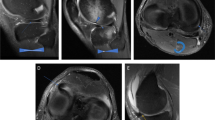Abstract
Objective
To test the hypothesis that in symptomatic patients, knees in which MRI examinations demonstrate no significant effusion will also be free of internal derangement.
Design and patients
One hundred and fifteen knee MRI examinations performed between March 2002 and June 2002 at our institution were retrospectively reviewed, evaluating for both the presence of knee effusions and concurrent internal derangement. The amount of joint fluid was measured quantitatively by obtaining anteroposterior measurements in the midline and lateral aspects of the suprapatellar pouch using sagittal MR images. These measurements were then correlated with presence or absence of MRI-demonstrated internal derangement and statistical analysis was performed.
Results
Of the 115 knee MRI examinations evaluated, 47 (41%) were negative for internal derangement and 68 (59%) were positive for internal derangement. Thirty-six of 115 (31%) examinations showed joint fluid with anteroposterior measurement of 10 mm or less in the lateral aspect of the suprapatellar pouch. Of these, 31 (86%) showed no concurrent internal derangement. Statistical analysis was also performed using other lateral suprapatellar pouch cutoff values.
Conclusion
While knees in which MRI examinations demonstrate no significant effusion are most often free of internal derangement, there remain a significant number which will exhibit internal derangement. An anteroposterior measurement of 10 mm or less in the lateral aspect of the suprapatellar pouch is a reasonable threshold value for distinguishing a physiologic from a pathologic amount of joint fluid.



Similar content being viewed by others
References
Hall FM. Radiographic diagnosis and accuracy in knee joint effusions. Radiology 1975; 115:49–54.
Schweitzer ME, Falk A, Berthoty D, Mitchell M, Resnick D. Knee effusions: normal distribution of fluid. AJR Am J Roentgenol 1992; 159:361–363.
Duncan JB, Hunter R, Pumell M, et al. Injured stable knee with acute effusion: MRI evaluation. J South Orthop Assoc (United States) 1996; 5(1):13–19.
McCarty DL. Synovial fluid. In: Koopman WJ, ed. Arthritis and allied conditions, 13th edn. Philadelphia: Williams and Wilkins, 1997:83.
Bolzan JA, 0’Sullivan JB, Cathcart ES. Unexpected prevalence of knee-joint effusions in the population of Sudbury. Arthritis Rheum 1972; 15:253–258.
Fishwick NG, Learmonth DJ, Finlay DB. Knee effusions, radiology and acute knee trauma. Br J Radiol 1994; 67:934–937.
Kaneko K, Demouy EH, Robinson AE. Distribution of joint effusions in patients with traumatic knee joint disorders: MRI assessment. Clin Imaging 1993; 17:176–178.
Author information
Authors and Affiliations
Corresponding author
Rights and permissions
About this article
Cite this article
Kolman, B.H., Daffner, R.H., Sciulli, R.L. et al. Correlation of joint fluid and internal derangement on knee MRI. Skeletal Radiol 33, 91–95 (2004). https://doi.org/10.1007/s00256-003-0707-0
Received:
Revised:
Accepted:
Published:
Issue Date:
DOI: https://doi.org/10.1007/s00256-003-0707-0




